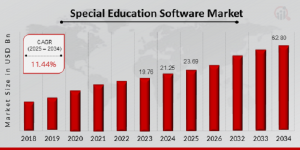Special Education Software Market Predicted to Hit 62.80 Billion by 2034
AI-powered special education software is transforming personalized learning and accessibility, driving significant growth
The global Special Education Software market is experiencing rapid growth, driven by an increased focus on enhancing learning experiences for students with diverse needs. Special education software is designed to support educators in delivering personalized, accessible, and effective learning experiences for students with disabilities, including learning disabilities, physical disabilities, and developmental delays. As the education sector continues to prioritize inclusivity, the adoption of specialized software tools has gained momentum, revolutionizing the way special education is approached across schools and educational institutions. With technological advancements, these solutions have become more comprehensive, integrating features such as speech-to-text, visual aids, and adaptive learning tools that cater to a wide range of disabilities. In 2024, the Special Education Software market was valued at several billion dollars, and it is expected to grow significantly in the coming years, with a robust compound annual growth rate (CAGR). The global push towards inclusive education, along with the increasing awareness about the importance of special education, is expected to continue driving the demand for these specialized software solutions.
Download Sample Pages: https://www.marketresearchfuture.com/sample_request/28011
Market Segmentation
The Special Education Software market can be segmented based on product type, deployment mode, end-user, and region. In terms of product type, the market is divided into Learning Management Systems (LMS), Speech and Language Therapy Tools, Behavior Management Tools, Assessment Tools, and Others. Learning management systems are the most widely used, providing teachers and students with platforms to access and manage educational content, track progress, and communicate. Speech and language therapy tools are another crucial segment, helping students with communication difficulties improve their language skills. Behavior management tools help educators monitor and modify students’ behavior, providing a more structured learning environment. The market is also segmented by deployment mode, with on-premises and cloud-based solutions being the two primary options. Cloud-based solutions are expected to dominate the market due to their scalability, lower initial costs, and ease of implementation. The end-user segment includes K-12 schools, higher education institutions, and others, with K-12 schools accounting for a significant portion of the market due to the higher demand for special education at the primary and secondary levels. The regional analysis includes North America, Europe, Asia-Pacific, Latin America, and the Middle East & Africa, with North America leading the market, followed by Europe, owing to favorable government policies and high adoption rates of special education software in these regions.
Market Key Players
Several key players dominate the Special Education Software market, offering a variety of innovative solutions to address the diverse needs of special education students. Leading companies such as:
• Voyager Sopris Learning
• Typing Agent
• Illuminate Education
• ClassLink
• Newsela
• X2VOLT
• Frontline Education
• Fishtree
• PowerSchool
• Click2Learn
• Wrightslaw
• Curriculum Associates
• Amitech
• Renaissance Learning
• SchoolPace
Browse In-depth Market Research Reports On Special Education Software Market: https://www.marketresearchfuture.com/reports/special-education-software-market-28011
Market Opportunities
The Special Education Software market offers a variety of opportunities for growth, particularly in emerging markets where the demand for inclusive education is rising. With an increasing number of governments and educational institutions recognizing the importance of special education, there is significant opportunity for software providers to develop and deploy solutions tailored to meet specific educational needs. The rise in personalized learning, where software adapts to individual students’ needs and progress, presents a tremendous opportunity for growth. Additionally, advancements in artificial intelligence (AI) and machine learning (ML) provide new opportunities for creating adaptive learning solutions that can cater to the specific needs of students with learning disabilities. For example, AI can help create personalized lesson plans based on the student's pace and learning style, further enhancing the learning experience. Cloud-based solutions are also presenting a considerable opportunity, as they allow educational institutions to implement these solutions at a lower cost and scale them as needed. Partnerships between educational institutions, technology providers, and governments to improve access to special education software are expected to drive market growth. Furthermore, as awareness of special education continues to increase globally, especially in developing regions, there is growing potential for market expansion in countries with underdeveloped special education systems.
Restraints and Challenges
Despite the promising growth prospects, the Special Education Software market faces several challenges and restraints that could hinder its expansion. One of the key challenges is the high cost associated with implementing special education software, particularly in low-income regions where budget constraints may limit adoption. While cloud-based solutions offer some relief, the initial costs of setting up these systems, especially for schools with limited resources, can be prohibitive. Another challenge is the lack of adequate training for teachers and school staff in effectively utilizing these software tools. Without proper training, educators may struggle to integrate the software into their daily routines, limiting its effectiveness. Furthermore, data privacy and security concerns pose significant challenges in the special education software market, as these tools often deal with sensitive information about students’ disabilities, academic progress, and personal data. Compliance with data protection regulations, such as the General Data Protection Regulation (GDPR) in Europe, is a critical concern for software providers and educational institutions. Additionally, the lack of standardization across various software solutions can create interoperability issues, making it difficult for schools to integrate different tools seamlessly.
Procure Complete Research Report Now: https://www.marketresearchfuture.com/checkout?currency=one_user-USD&report_id=28011
Regional Analysis
The Special Education Software market is experiencing varying levels of adoption across different regions, driven by local policies, educational standards, and economic factors. North America dominates the market due to the high adoption rate of technology in education and strong government initiatives promoting inclusive education. The United States, in particular, has several policies and frameworks that encourage the use of assistive technologies in special education, making it one of the largest markets for special education software. Europe follows closely, with countries like the United Kingdom, Germany, and France investing heavily in inclusive education technologies. The growing emphasis on accessibility and inclusion in these regions is contributing to the market’s expansion. In Asia-Pacific, the market is witnessing significant growth, particularly in countries like China, India, and Japan, where governments are increasingly focusing on enhancing special education facilities and digitalization in schools. The Latin American and Middle Eastern markets are still in the early stages of adoption, but the increasing awareness of special education needs and government initiatives to improve education accessibility in these regions present substantial growth opportunities.
Recent Developments
Recent developments in the Special Education Software market reflect the growing demand for innovative solutions that cater to the diverse needs of students with disabilities. Companies are increasingly integrating AI and machine learning into their platforms to provide personalized learning experiences. Cloud-based solutions continue to gain traction, offering educational institutions a more cost-effective and scalable option. Several partnerships and collaborations have been formed between software providers and educational institutions to improve the accessibility of special education tools. Moreover, the COVID-19 pandemic accelerated the adoption of digital tools in education, further driving the demand for special education software as schools and educators look for ways to support students remotely. Innovations in speech recognition, interactive learning platforms, and assistive technology are also shaping the future of the market, enabling more students to benefit from tailored educational experiences.
Related Reports:
Energy Security Market:
https://www.marketresearchfuture.com/reports/energy-security-market-26621
Augmented Reality Glas Market:
https://www.marketresearchfuture.com/reports/augmented-reality-glas-market-26402
Cloud Logistic Market:
https://www.marketresearchfuture.com/reports/cloud-logistic-market-26413
Commodity Supply Chain Management Solution Market:
https://www.marketresearchfuture.com/reports/commodity-supply-chain-management-solution-market-26483
Computational Fluid Dynamic Market:
https://www.marketresearchfuture.com/reports/computational-fluid-dynamic-market-26503
Made In The USA Announces Top ARTIST Awards, and an Evening TAG Art Auction next weekend
NewSky Security Expands into Cyber Security Private Investigations to Combat Sophisticated Botnet and VPN Threats
CTO G. Vimal Kumar of Cyber Privilege Honored for Advancing Cyber Forensics and Digital Evidence in India
Kalendarium
Więcej ważnych informacji
 Jedynka Newserii
Jedynka Newserii

 Jedynka Newserii
Jedynka Newserii

Prawo

KE proponuje nowy Fundusz Konkurencyjności. Ma pobudzić inwestycje w strategiczne dla Europy technologie
W środę 16 lipca Komisja Europejska przedstawiła projekt budżetu na lata 2028–2034. Jedna z propozycji zakłada utworzenie Europejskiego Funduszu Konkurencyjności o wartości ponad 400 mld euro, który ma pobudzić inwestycje w technologie strategiczne dla jednolitego rynku. Wśród wspieranych obszarów znalazła się obronność i przestrzeń kosmiczna. Na ten cel ma trafić ponad 130 mld euro, pięciokrotnie więcej niż do tej pory.
Firma
Były prezes PGE: OZE potrzebuje wsparcia magazynów energii. To temat traktowany po macoszemu

Choć udział odnawialnych źródeł energii w miksie energetycznym Polski jest stosunkowo wysoki i rośnie, to ten przyrost jest chaotyczny i nierównomiernie rozłożony miedzy technologiami – wskazuje Forum Energii. Dodatkowo OZE potrzebują wsparcia magazynów energii, a zdaniem Wojciecha Dąbrowskiego, prezesa Fundacji SET, ten temat jest traktowany po macoszemu. Brak magazynów powoduje, że produkcja energii z OZE jest tymczasowo wyłączana, co oznacza marnowanie potencjału tych źródeł.
Infrastruktura
Wzrost wynagrodzeń ekip budowlanych najmocniej wpływa na koszty budowy domu. Zainteresowanie inwestorów mimo to nieznacznie wzrasta

Budowa metra kwadratowego domu w Polsce kosztuje od 5,55 do 6 tys. zł w zależności od województwa – wynika z najnowszych analiz firmy Sekocenbud. Najdrożej jest w Warszawie, gdzie cena za metr kwadratowy domu przekroczyła już 6,2 tys. zł. Na przyrosty kosztów budowy domu wpływają zarówno drożejące materiały budowlane, jak i wyższe wynagrodzenia pracowników. Inwestorzy nie rezygnują jednak z budowy domów jednorodzinnych, co ma związek m.in. z wciąż wysokimi cenami mieszkań czy też obniżką stóp procentowych.
Partner serwisu
Szkolenia

Akademia Newserii
Akademia Newserii to projekt, w ramach którego najlepsi polscy dziennikarze biznesowi, giełdowi oraz lifestylowi, a także szkoleniowcy z wieloletnim doświadczeniem dzielą się swoją wiedzą nt. pracy z mediami.









.gif)

 |
| |
| |
|